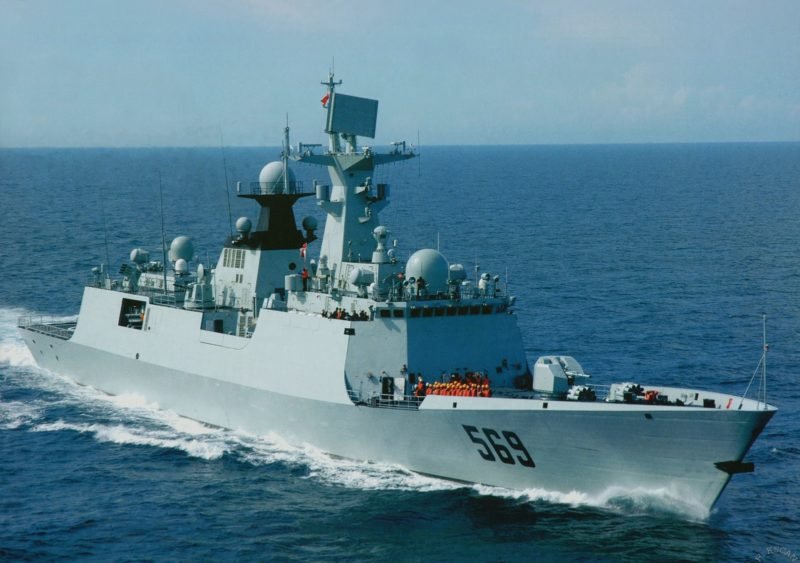The Dragon of the Sea

The South China Sea (SCS) has been the centre of intense power manifestation and regional assertiveness in the recent past. Encompassing an area of 3.5 million square kilometres, the sea is a subsidiary of the Western Pacific Ocean and is an important trade channel in East Asia, connecting the subregion to India, West Asia, Europe and Africa. Every year, the sea enables the trade of over $3.37 trillion, making it one of the most significant trade routes in the world. SCS is resource-rich, with at least 11 billion barrels of untapped oil and 190 trillion cubic feet of natural gas. This has led to competing claims by countries bordering the sea, which often extend beyond the internationally designated 200 nautical mile Exclusive Economic Zone (EEZ). These countries include Vietnam, the Philippines, Indonesia, etc. However, the most assertive claim is made by China, based on the historical ‘Nine-Dash Line’, a Chinese concept which demarcates most of the region as its sovereign waters. China reinforces its control on the region in multiple ways, including expanding existing islands, building artificial islands altogether, constructing ports, military outposts and air-strips.
China attaches tremendous importance to the region as it serves as a tool for establishing greater Sino-influence in the region and further legitimises its claim as an antithesis to American hegemony. Greater influence over the region ensures a Chinese enclave in regional security discussions, it enables China to present itself as a dominant power in proximity, which might force neighbouring nations to rethink their security arrangements and foreign policy to some extent. Chinese actions in the SCS have raised several eyebrows in the global north, while the United States of America(USA) refuses to back any single claimant, it still is an important actor in the dispute. In an effort to tackle Chinese actions in the region, the USA has stepped up its naval presence in the SCS with regular Freedom of Navigation Operations (FoNOPs). The USA believes that Oceans and Seas form a part of the “Global Commons”, characterised by universal ownership of all countries. Chinese actions reduce American ability to undertake naval operations when need be and threatens its trade and foreign policy interests, making the region an arena of increasing Chinese dominance with US counter-efforts.

Chinese assertiveness and regional dominance
China considers its position in the SCS as an important national interest. According to Exclusive Economic Zone (a concept adopted by the UN which grants coastal countries a right to explore and exploit marine resources in its adjacent section of the continental shelf up to 200 nautical miles). In contrast to this concept, China claims sovereignty over an area extending up to 2000 km from the Chinese mainland by virtue of the Nine-Dash Line. Since 2013, it has created over 3200 acres of new land in the Spratly Islands, where it occupies seven sites. It has engaged in active reclamation at especially three sites- Fiery Cross Reef, Subi Reef, and Mischief Reef, all of which have airfields, a substantial number of buildings and other structures. This infrastructural arrangement helps China to impose its will in the region, further its economic, foreign policy and military interests. In July 2016, a UN tribunal in the Hague rejected Chinese claims and ruled that China had no historic rights in the SCS, this ruling was dismissed by Beijing as it continues to expand itself in the region.
A strong position in the SCS gives China control over the vast resources of the region, including oil, natural gas and fisheries. It enables China to exploit and further explore these resources. Moreover, it would enable China to regulate the $3.37 trillion trade to some extent, the increase in Chinese regulation due to this might initially be marginal, but it still serves its interests in some way, something which China might aspire in the future. U.S. Navy Admiral Philip Davidson in 2018 stated that “China is now capable of controlling the South China Sea in all scenarios short of war with the United States.” This tells us a great deal about the extent to which China has militarily entrenched itself in the region. In the event of a direct confrontation between the US and China, these establishments will restrict American access to the Chinese mainland, creating a security bastion.
The direct utility of the military establishments can be questioned in times of peace, however, the establishments serve more of a symbolic purpose. It enables China to project itself as a dominant military power capable of competing with the US. It reinforces China’s image as a hegemon in Asia, capable of influencing economic, political and security interests of other Asian countries. China’s stronghold in the SCS helps it diplomatically as well. It becomes possible regional security and economic partner for Asian countries as countries in proximity would prefer to have a powerful friend over a powerful enemy near their borders. It also gives these countries a greater bargaining power while negotiating relations with the US, since they always have the possibility of approaching the dragon if the eagle doesn’t comply.

American interests and response
China’s position that coastal states have the right to regulate the activities of foreign military forces in their EEZs has been contested by the US. The position of the United States is that while the United Nations Convention on the Law of the Sea (UNCLOS), gives coastal states the right to regulate economic activities within their EEZs, it does not give coastal states the right to regulate foreign military activities in the parts of their EEZs beyond their 12-nautical-mile territorial waters. As a response to Chinese assertiveness in the region, the US conducts freedom of navigation operations in the SCS thereby increasing its naval presence in the region.
Yet another bone of contention is the definition of “freedom of navigation”, which is systematically narrowed down by China to suit its interests. A settlement on the definition seems unlikely given the vested interests of the two countries. The US has security agreements with Japan, the Philippines and Taiwan and hence has an inherent responsibility to counter Chinese dominance in the region. The US has trade interests in the region which it has to protect, 80 percent of the crude oil imported by key US allies in proximity to the Chinese mainland- Japan, South Korea and Taiwan flows through the SCS. Several observers have also pointed out that lack of clarity in the USA’s policy in the SCS gives a leeway to China to impose its will.
Given the plausible propensity of the regional security architecture taking a pro-China turn, even slowly, questions the dependability of the US in the eyes of regional allies. This becomes a key reason why it is in the best interests of the US to tackle Chinese influence from further increasing. Chinese military establishments on the islands have not been expanded after 2018, which might mean that China has reached its objective of militarizing the SCS, which serve more of a symbolic purpose. It continues to voice its claim for sovereignty through conventional rhetoric, diplomatic measures and improving relations with its neighbours slowly and calmly. The United States cannot afford to be a fence sitter at a time when the red moon is rising.



















